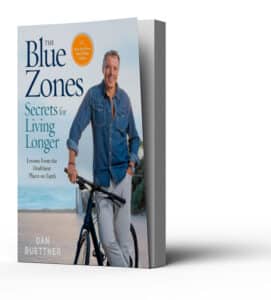What’s the best way to live a longer and healthier life?
Most of us would get no argument if we said health comes from simple but important changes in our lives, like riding a bike or walking to work and eating more plant-based foods and whole grains. But Dan Buettner, a National Geographic Fellow and author of the new book, “The Blue Zones Secrets for Living Longer: Lessons from the Healthiest Places on Earth,’’ the latest in his Blue Zone series, says diet and exercise are just part of the story.
 “Healthier, longer lives also come from social connectedness and living a life of purpose. In blue zones, they don’t warehouse their old in retirement homes, which are COVID pits, and so these zones didn’t do so bad during the pandemic. Because they have a much lower rate of chronic diseases, there is less chance of mortality from COVID,’’ Buettner said at a recent Stanford University Longevity Book Club webinar.
“Healthier, longer lives also come from social connectedness and living a life of purpose. In blue zones, they don’t warehouse their old in retirement homes, which are COVID pits, and so these zones didn’t do so bad during the pandemic. Because they have a much lower rate of chronic diseases, there is less chance of mortality from COVID,’’ Buettner said at a recent Stanford University Longevity Book Club webinar.
“Our research into these zones shows that the first and best source of longevity is to keep aging parents nearby. We call it the grandmother factor,” says Buettner, whose “Live to 100: Secrets of the Blue Zones” docuseries is now showing on Netflix.
“When grandma is at home, she maintains the food tradition, she maintains the garden, she takes care of the grandkids when mom goes to work,” he says. “The grandfather living at home has agriculture knowledge. He has the wisdom to know when to plant and when to sow, when to harvest, and how to make the wine.”
“Respecting that wisdom, blue zones show, is good for everybody. It also turns out to be good for the older people themselves, who have a reason to get up and feel like they are useful,’’ said Buettner.
Blue-zone origins
About 15 years ago, as part of a National Geographic project, Buettner identified the places that he said posed great mysteries of life — such as why super-agers in these locales live disability-free lives.
“My brother, Nick, who was working with me, had stumbled on this 1999 report that said in Okinawa, they had the longest disability-free expectancy in the world. I said, ‘Ah-ha, that is a good mystery.’ Okinawa is a melting pot so it’s not genetic. So what was it?’’
After touring Okinawa, Buettner decided to draw a blue line around each area that a worldwide network of demographers had identified as having communities of super-agers living disease-free lives. The five blue zones he’s written about in his books — including cookbooks — are Sardinia, Italy; Nicoya, Costa Rica; Ikaria, Greece; Okinawa, Japan; and Loma Linda, California.
Additional Reading: Retired Wall Streeter, 82, Inspires Super-agers
As Buettner writes in his latest book that, “People living in the blue zones are just as human as us, and their health advice touches on many familiar themes: purpose, faith, community, rest, exercise, healthy diet, and so on.
“But blue zoners don’t struggle nearly so much as us to make all of those factors work harmoniously, and it makes an enviable difference: they live 10-plus years longer on average, and they’re healthier all the way from cradle to grave.’’
Lifelong learning and intergenerational socializing help
During the Longevity Book Club meeting, Martha Deevy of the Longevity Project asked Buettner if lifelong learning fits in with blue zone healthy living.
His respond: “Long life expectancy is associated with adult education, so lifelong learning is good for all of us. In blue zone communities, men and women continue to use their minds as they age; they always have a craft that keeps their brain engaged. It’s not like they are tottering off to classes but they are always learning.’’
The generations also keep connected through community socializing.
“In Costa Rica, 90 villages have a huge party that starts during the day and goes until 8 the next morning with drinking of wine and dancing and twirling. It’s not just a bunch of 20-year-olds. You have 80-, 90- and 100-year-olds show up for the community,” he says. “You have to pay for your wine and your food, which is all donated, and then the money they raise goes into community projects.”
Not necessarily in the genes
Buettner, who is slim and youthful looking at 63, holds several Guinness World Records for longest endurance cycling times, and he eats the way blue zoners do — plenty of beans, vegetables and whole grains. He starts his day with a breakfast of homemade minestrone soup. And, he is not one to wag a finger at those who drink wine moderately.
“We often thought there was a genetic component to the super-agers in Sardinia, because Sardinia has a genetically pure population. But when we looked at the spouses of centenarians, they don’t share any genetic overlap, but they are more likely to live to be centenarians than a centenarian’s brother!”
“That proves that there is a lifestyle contagion — that it might be from a bacterial exchange. If you live with a centenarian, you are kissing, your spouse and you are sharing a pot of food. And I just read, of the 90-year-olds in Sardinia, over 80% drank wine every day of their lives,” said Buettner.
“I know there is controversy over alcohol but I can tell you blue zoners are drinking moderately every day, usually with friends and food, and they are still making it into their 90s with a fraction of the chronic disease that Americans have.’’
Beware American processed food
Buettner is concerned that the American way of eating and globalization of food threaten blue zones. “As soon as American food comes in, longevity goes out the door. Okinawa is no longer a blue zone because of that. It’s not a healthy place to live anymore,” he said.
“Costa Rica breaks my heart. It was one of the greatest examples of longevity in the world but it is now letting in the Burger Kings, the McDonalds – the standard American diet for the average 20-year-old, which shaves 10 years off your life expectancy, as compared to blue zones’ whole plant-based diet. Since they’ve adopted these foods, their obesity and diabetes are shooting upward. It will lose its longevity in a half generation.’’
Buettner goes on the road with the Blue Zones project to American cities, and those that provide healthy eating choices at restaurants, schools and churches receive Blue Zone certification. There are 72 in the United States, including Jacksonville and Naples, Florida; Fort Worth, Texas; Scottsdale, Arizona; and San Luis Obispo, Palo Alto and Santa Barbara, California.
He works in partnership with municipal governments, large employers and health insurance companies to implement Blue Zones Projects, which are initiatives that focus on changes to the local environment, public policy and social networks.
“When we come to a city, we don’t try to force things or try to convince meat eaters to not eat meat. We don’t tell folks what to do. Rather, we go through a process. We say, ‘Here are policy menus that have worked elsewhere.’
“Often, it’s, ‘Is there a political will to get this done in five years?’ It’s rethinking a policy for healthy eating, more moving, social connectedness and purpose.’’
Still hopeful
Ken Stern of the Longevity Project asked Buettner if it is realistic to believe the United States can change its unhealthy eating, isolation and sedentary ways.
“The consensus is that if the federal government brought together the best thinkers in America who knew how to design cities for healthy living and then listened to what these thinkers believe is effective and feasible, we would do better.,” Buettner replied. “Cities that are walkable have much higher economic vitality than cities that are crisscrossed with traffic.”
“There is no villain here but since the 1970s, when Earl Butts was the secretary of agriculture and he created all these incentives to go grow wheat, soy, rice and give that to American food companies, we have become too good at creating empty calorie foods that taste irresistible, and Madison Avenue has gotten too good at marketing them,” says Buettner.
“If we diverted one quarter of the $4.4 trillion that we are shoveling at this problem to help keep people healthy in the first place then we could start shifting subsidies to what’s good for us: beans, whole grains, fresh fruit. Everybody likes fresh fruit, but in this system it’s so expensive. Not everybody can afford it.’’
To avoid isolation, especially in retirement, Buettner suggested volunteering for a cause that appeals to your personal likes. He treats friends to lunch twice a week in his home city of Miami (where he lives in the cold months; otherwise, he’s in Wisconsin).
“I’m making good friends; friends measurably impact our behavior. Technology can facilitate bringing people together, like if you’re using Instagram to find like-minded people to play racquetball with. But sitting in a house scrolling for two hours, no, it’s not going to do it,” he says.
In a four-decade career in journalism, Eleanor O’Sullivan has reviewed many books on best practices for financial advisors, has written for Financial Advisor and the USA Today network, and was movie critic for the Asbury Park Press.







